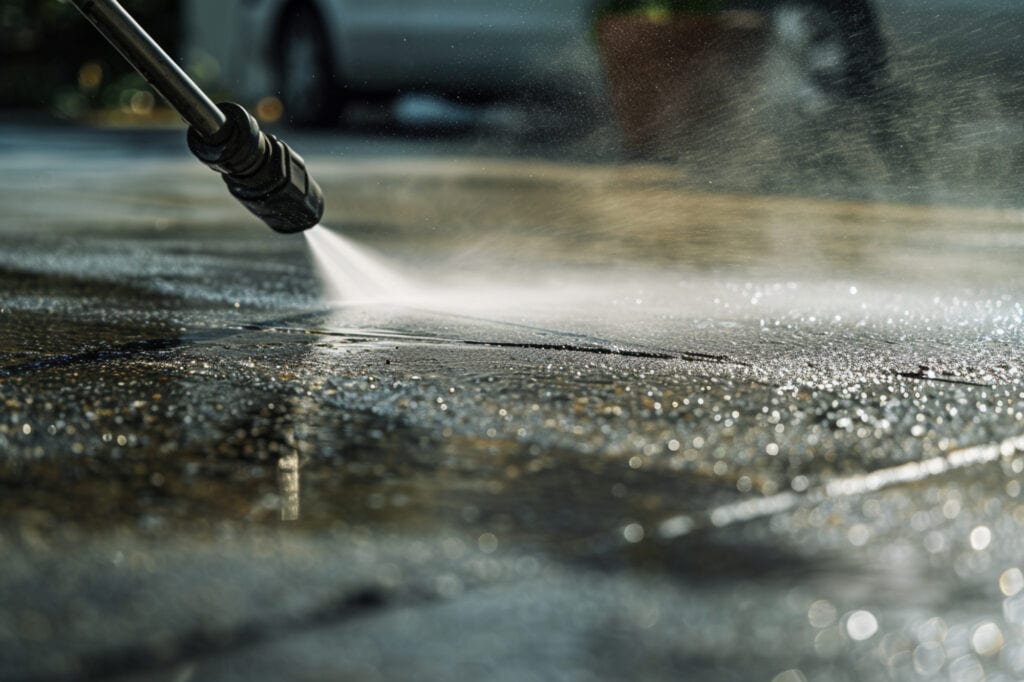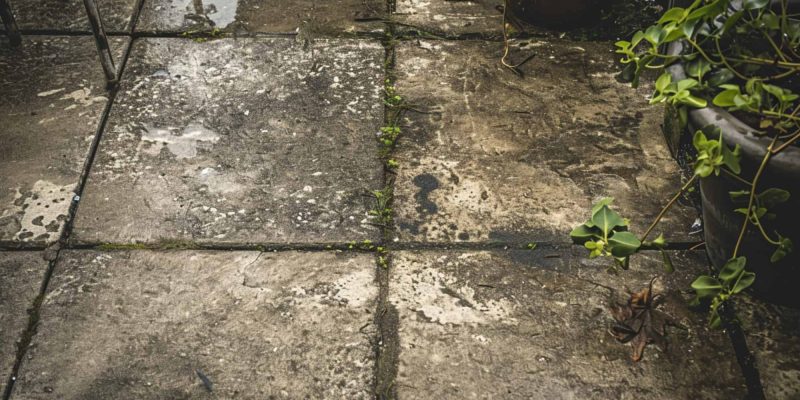With a few simple steps, you can transform your outdoor space into a clean and inviting area. Whether you’re dealing with everyday dirt or stubborn stains, this guide will walk you through the most effective ways to clean your patio, no professionals needed!
Understanding Your Patio’s Needs
Before you start scrubbing away, it’s crucial to assess the specific needs of your patio. This initial step will not only make your cleaning efforts more effective but also ensure that you’re addressing any potential issues correctly. From identifying the type of stains to taking necessary safety measures, understanding your patio’s unique requirements is the first step towards a cleaner outdoor space.
Assessing Your Patio’s Condition
Before diving into cleaning, take a moment to examine your patio. Look for common issues like mold, mildew, or oil stains. Understanding the type of dirt or stain you’re dealing with will help you choose the right cleaning method.
Safety Precautions
Safety comes first! Always wear protective gloves and eyewear, especially when handling chemical cleaners. If you’re using homemade solutions, be mindful of their ingredients. Keep pets and children away from the cleaning area to ensure their safety.
Basic Cleaning Techniques
Before tackling tough stains, it’s essential to start with basic cleaning steps to set the stage for a more detailed clean. These simple yet effective techniques are the foundation of maintaining your concrete patio’s cleanliness and appearance.
Sweeping and Rinsing
Begin by sweeping away leaves, twigs, and debris. A thorough sweep prepares your patio for deeper cleaning. Next, rinse the surface with a garden hose. This removes loose dirt and helps you spot tougher stains that need more attention.
DIY Cleaning Solutions
For general cleaning, mix equal parts water and white vinegar in a bucket. This solution is effective for mild stains and safe for the environment. Another great option is a mix of dish soap and water. It’s gentle on concrete and effective for removing grime.
Removing Common Stains
Tackling common stains on your concrete patio doesn’t have to be daunting. This section guides you through effective ways to remove the typical culprits of patio discoloration such as organic matter, grease, oil, rust, and red mud. These methods leverage household items and simple techniques to restore your patio’s beauty.
Organic Stains (Mold, Mildew, Algae)
These are the most common culprits for patio discoloration. For a natural and effective remedy, mix equal parts of water and white vinegar. Pour this solution directly onto the mold, mildew, or algae, ensuring the area is fully soaked. Let this sit for about 10-15 minutes. The acidity in the vinegar works to break down the organic material. Then, using a stiff-bristled brush, scrub the area in a circular motion to lift the stains. Rinse thoroughly with water.
TIP
For persistent stains, a stronger approach involves creating a paste using baking soda and water. Apply this paste generously over the stain, allow it to dry for 15-20 minutes, then scrub and rinse. This method is particularly effective as baking soda is a gentle abrasive, making it perfect for tougher stains without damaging the concrete.
Grease and Oil Stains
Common in areas near barbecue grills or cars, grease and oil can be tricky. Begin by sprinkling absorbent materials such as kitty litter, cornstarch, or baking soda over the stain. These materials soak up the excess oil, making cleaning easier. Let it sit for a few hours or even overnight for best results, then sweep it up. If the stain persists, apply a small amount of dish soap directly onto the stain. Scrub with a brush, adding a bit of water to create a lather. This method is effective as dish soap is designed to cut through grease. Rinse off the soap thoroughly with water.
Rust and Red Mud Stains
Rust stains, often caused by metal furniture, can be treated with a paste made from lemon juice and salt. The citric acid in lemon juice helps to break down the rust. Apply the paste, let it sit for about 10-15 minutes, then scrub vigorously and rinse. For red mud, which is common in certain soils, use a strong solution of water and laundry detergent. Scrub the area with a brush to penetrate the stain, then rinse with water.
Advanced Cleaning Techniques

When basic cleaning isn’t enough, it’s time to bring out the big guns. This section explores advanced cleaning techniques that are still within the reach of a DIY enthusiast. These methods are designed to tackle the most stubborn stains, offering solutions that range from alternative methods to pressure washing to using specialized outdoor cleaners.
Pressure Washing Alternatives
Not everyone has access to a pressure washer, and that’s okay. Non-caustic cleaners are a great alternative. These cleaners are designed to be tough on stains but gentle on your patio. To use, dilute the cleaner as per the instructions, usually in a 1:1 ratio with water. Pour this mixture into a garden sprayer for easy application. Spray the solution evenly across the patio, covering all stained areas. Allow it to sit for about 15 minutes. This gives the cleaner time to react with the stains. After the wait, rinse the area with a hose. This method is particularly useful for large patios or when dealing with multiple types of stains.
30 Seconds Outdoor Cleaner
This cleaner is specifically formulated for outdoor use and is highly effective against stubborn stains. To use, mix it with water in equal parts. Apply it generously to the stained areas of your patio. Let the solution sit for a set duration as per the product instructions, usually around 15 minutes. This time allows the cleaner to penetrate and lift the stains. Afterward, rinse the area thoroughly with water. This cleaner is a great option for those who want a quick and effective cleaning solution without the potential damage of pressure washing.
Muriatic Acid Use
Muriatic acid is a powerful cleaning agent but should be used with extreme caution. It’s effective for removing very stubborn stains like paint or some types of mineral deposits. Always wear protective gear, including gloves and goggles, when handling muriatic acid. Dilute the acid in water as per the manufacturer’s instructions, usually one part acid to 10 parts water. Apply the solution carefully to the stained area, and do not let it sit for more than a few minutes. Rinse the area immediately with plenty of water. After cleaning, neutralize the area with a baking soda and water solution to ensure safety. This method should only be used as a last resort due to the potential risks involved.
Maintenance and Prevention
Maintaining a pristine patio goes beyond occasional deep cleaning; it’s about implementing consistent care and preventive measures. This section is dedicated to guiding you through effective maintenance strategies and tips to prevent common patio issues. By adopting these practices, you can ensure your patio remains a welcoming and beautiful space for years to come.
Regular Cleaning Schedule
Consistency is key in maintaining a clean patio. Regular sweeping and rinsing can prevent the buildup of dirt and grime. It’s recommended to perform a thorough cleaning at least once a year. Set a schedule for a deep clean, ideally in the spring or fall. This involves using the cleaning techniques mentioned earlier to tackle any new or lingering stains. By keeping up with this schedule, you not only maintain the aesthetic appeal of your patio but also extend its lifespan.
Sealing Your Patio
After a thorough cleaning, consider sealing your patio. A concrete sealer provides a protective layer against moisture, stains, and weather-related wear. This is particularly useful in Joliet’s varied climate. Sealers come in different finishes, from matte to glossy, allowing you to choose based on your aesthetic preference. Applying a sealer every two to three years can drastically reduce the frequency of deep cleanings and protect your patio from the elements.
Proactive Measures
When it comes to patio maintenance, being proactive is better than reactive. Clean spills immediately to prevent them from setting in and becoming stubborn stains. Use mats in high-traffic areas, especially near entrances and outdoor dining areas, to minimize wear and dirt accumulation. If you have outdoor furniture, consider using protective covers, especially during harsh weather conditions, to prevent rust and other stains. Regularly inspect your patio for any cracks or damages as these can become breeding grounds for weeds and moss, complicating your cleaning efforts.
Conclusion
Congratulations on taking the first step towards a cleaner patio! With these simple, effective methods, you can maintain a beautiful concrete patio right here in Joliet. Remember, regular care makes a big difference. Enjoy your refreshed patio and the satisfaction of doing it yourself!

